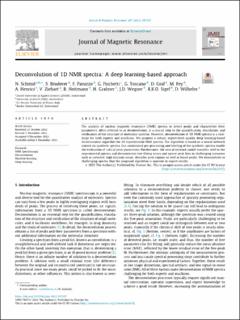Bitte benutzen Sie diese Kennung, um auf die Ressource zu verweisen:
https://doi.org/10.21256/zhaw-26697| Publikationstyp: | Beitrag in wissenschaftlicher Zeitschrift |
| Art der Begutachtung: | Peer review (Publikation) |
| Titel: | Deconvolution of 1D NMR spectra : a deep learning-based approach |
| Autor/-in: | Schmid, N. Bruderer, S. Paruzzo, F. Fischetti, G. Toscano, G. Graf, D. Fey, M. Henrici, A. Ziebart, V. Heitmann, B. Grabner, H. Wegner, J.D. Sigel, R.K.O. Wilhelm, D. |
| et. al: | No |
| DOI: | 10.1016/j.jmr.2022.107357 10.21256/zhaw-26697 |
| Erschienen in: | Journal of Magnetic Resonance |
| Band(Heft): | 347 |
| Heft: | 107357 |
| Erscheinungsdatum: | Feb-2023 |
| Verlag / Hrsg. Institution: | Elsevier |
| ISSN: | 1090-7807 1096-0856 |
| Sprache: | Englisch |
| Schlagwörter: | NMR spectroscopy; Deconvolution; Machine learning; Deep learning |
| Fachgebiet (DDC): | 006: Spezielle Computerverfahren 530: Physik |
| Zusammenfassung: | The analysis of nuclear magnetic resonance (NMR) spectra to detect peaks and characterize their parameters, often referred to as deconvolution, is a crucial step in the quantification, elucidation, and verification of the structure of molecular systems. However, deconvolution of 1D NMR spectra is a challenge for both experts and machines. We propose a robust, expert-level quality deep learning-based deconvolution algorithm for 1D experimental NMR spectra. The algorithm is based on a neural network trained on synthetic spectra. Our customized pre-processing and labeling of the synthetic spectra enable the estimation of critical peak parameters. Furthermore, the neural network model transfers well to the experimental spectra and demonstrates low fitting errors and sparse peak lists in challenging scenarios such as crowded, high dynamic range, shoulder peak regions as well as broad peaks. We demonstrate in challenging spectra that the proposed algorithm is superior to expert results. |
| URI: | https://digitalcollection.zhaw.ch/handle/11475/26697 |
| Volltext Version: | Publizierte Version |
| Lizenz (gemäss Verlagsvertrag): | CC BY 4.0: Namensnennung 4.0 International |
| Departement: | School of Engineering |
| Organisationseinheit: | Institut für Angewandte Mathematik und Physik (IAMP) Institut für Datenanalyse und Prozessdesign (IDP) |
| Publiziert im Rahmen des ZHAW-Projekts: | Maschinelles Lernen für NMR-Spektroskopie |
| Enthalten in den Sammlungen: | Publikationen School of Engineering |
Dateien zu dieser Ressource:
| Datei | Beschreibung | Größe | Format | |
|---|---|---|---|---|
| 2022_Schmid-etal_Deconvolution-of-1D-NMR-spectra_JMR.pdf | 2.43 MB | Adobe PDF |  Öffnen/Anzeigen |
Zur Langanzeige
Schmid, N., Bruderer, S., Paruzzo, F., Fischetti, G., Toscano, G., Graf, D., Fey, M., Henrici, A., Ziebart, V., Heitmann, B., Grabner, H., Wegner, J. D., Sigel, R. K. O., & Wilhelm, D. (2023). Deconvolution of 1D NMR spectra : a deep learning-based approach. Journal of Magnetic Resonance, 347(107357). https://doi.org/10.1016/j.jmr.2022.107357
Schmid, N. et al. (2023) ‘Deconvolution of 1D NMR spectra : a deep learning-based approach’, Journal of Magnetic Resonance, 347(107357). Available at: https://doi.org/10.1016/j.jmr.2022.107357.
N. Schmid et al., “Deconvolution of 1D NMR spectra : a deep learning-based approach,” Journal of Magnetic Resonance, vol. 347, no. 107357, Feb. 2023, doi: 10.1016/j.jmr.2022.107357.
SCHMID, N., S. BRUDERER, F. PARUZZO, G. FISCHETTI, G. TOSCANO, D. GRAF, M. FEY, A. HENRICI, V. ZIEBART, B. HEITMANN, H. GRABNER, J.D. WEGNER, R.K.O. SIGEL und D. WILHELM, 2023. Deconvolution of 1D NMR spectra : a deep learning-based approach. Journal of Magnetic Resonance. Februar 2023. Bd. 347, Nr. 107357. DOI 10.1016/j.jmr.2022.107357
Schmid, N., S. Bruderer, F. Paruzzo, G. Fischetti, G. Toscano, D. Graf, M. Fey, et al. 2023. “Deconvolution of 1D NMR Spectra : A Deep Learning-Based Approach.” Journal of Magnetic Resonance 347 (107357). https://doi.org/10.1016/j.jmr.2022.107357.
Schmid, N., et al. “Deconvolution of 1D NMR Spectra : A Deep Learning-Based Approach.” Journal of Magnetic Resonance, vol. 347, no. 107357, Feb. 2023, https://doi.org/10.1016/j.jmr.2022.107357.
Alle Ressourcen in diesem Repository sind urheberrechtlich geschützt, soweit nicht anderweitig angezeigt.